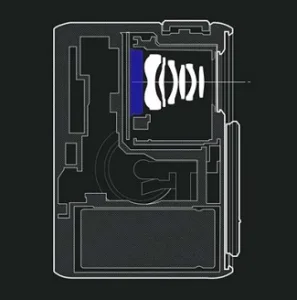Cameras are not an area that we often delve into, but we wanted to highlight the DxO One – a smartphone companion, billed as ‘the world’s first truly connected camera’.
The lens is held close to the sensor (blue), which enables the camera’s small design. DxO’s technologies help to combat some of the problems, such as colour cross-talk, introduced by this design.Measuring 48.2 x 25.4 x 67.3mm, the pocket-sized camera is intended to raise the quality of iPhone pictures. In fact, while it can be used as a standalone camera, the unit isn’t even built with a viewfinder: the iPhone screen serves that purpose, connected via a Lightning cable. Because much of the processing (and screen) are on the phone or a desktop PC, the camera is small, light and low-power.
The sensor is a 1″ BSI-CMOS unit from Sony, with high dynamic range. Combined with the F1.8 (fixed-zoom) lens, the camera is said to offer superior low light performance and more control over the depth-of-field than the iPhone – even before the in-built image processing.
To enable the camera’s small size, the lens and sensor sit very close together – although it was found that this can lead to colour cross-talk (light rays mapped to the wrong pixel). DxO developed technology to counteract this issue, ensuring that colour information is preserved at the pixel level.
The camera can output images in Raw format, and incorporates a ‘SuperRAW’ feature. This captures four Raw images in rapid succession. They can be combined (using desktop software), to create a high-quality, low-noise image. DxO claims that this ‘should’ lead to a 2 EV (exposure value) increase in noise performance. Various processing also avoids ghosting and attempts de-blurring. Video (1920 x 1080 at 30fps) can also be recorded using the DxO One.
Connecting the camera to an iPhone will open the app store at the relevant DxO app. Camera firmware updates are rolled into the app updates, which is a very handy feature.
Analyst Comment
This is a really interesting product, and obviously targets the casual photographer market – those who ‘make do’ with smartphones, because they don’t want to bother carrying a camera. Fitting in a pocket, with a nice flat design, the DxO One may remedy that.
However, it is also possible that this is a niche product for a niche market. Many of these casual photographers don’t care about incremental quality improvements; a wider angle or more capable zoom would be a more welcome addition. As one commenter noted, ‘No-one who needs it will know about it, and no-one who knows about it will need it’! (TA)
DxO has a lot of digital technology for optimising imagery that compensates for known lens design issues – I use it when I care about the image quality of my photos. It recognises the camera body and lens and compensates. That kind of technology should be very helpful in delivering better results with low quality components. (BR)

